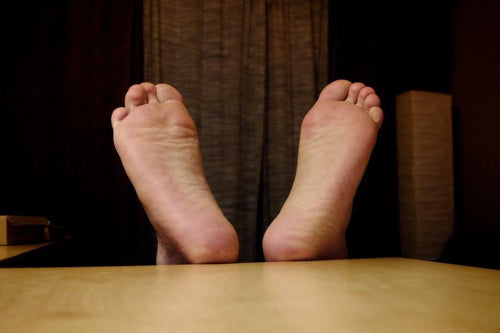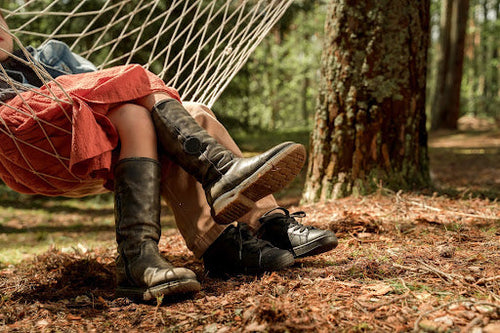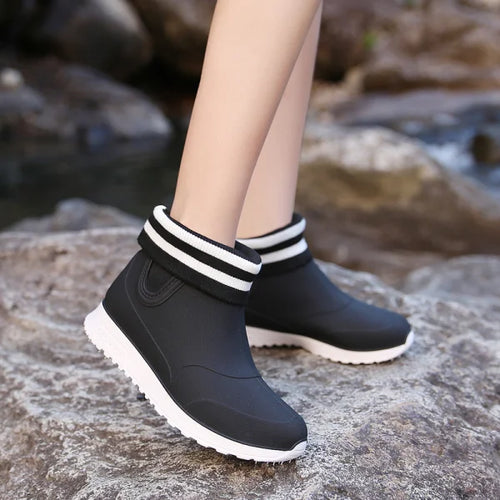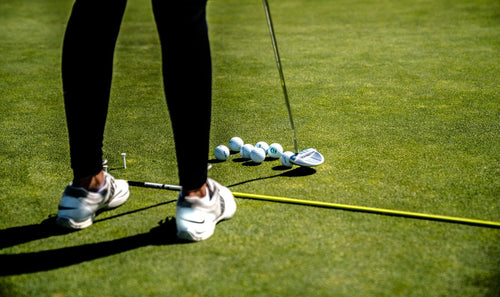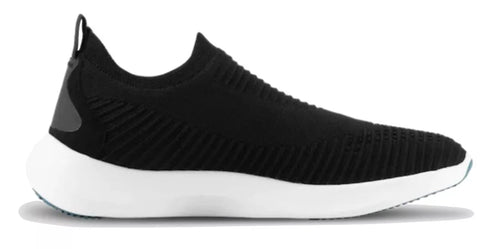New Balance Fresh Foam, Nike Air, ASICS Gel, Puma Ignite, Adidas Boost- what do all of these running shoe lines have in common? The names of these iconic shoe lines across the most popular shoe brands all directly mention the cushioning technology they employ.
But what’s the reason?
Well, cushioning is such an integral factor of waterproof running shoes that many brands incorporate their respective cushioning technologies into the shoe name. In fact, moderate to high levels of cushioning are a defining feature of modern running footwear. Since running is such a high-impact activity, well-cushioned running shoes help prevent major injuries.
Likewise, runners and athletes always look at the cushioning factor before buying new running footwear.
But here’s the kicker: many people are now swiftly adopting the practice of “barefoot” running, which requires thin-soled, non-cushioned shoes.
So, what should you go for? Let’s find out.
How To Select The Right Running Shoes Cushioning Level
Things like fit, style, and durability are all crucial factors in finding the perfect running shoes.
However, all of that comes secondary to the most important decision of all: how much cushioning do you want?

For a long time, the convention was that high cushioning unquestionably reduces the risk of injuries among all runners. However, recent studies suggest that everyone’s foot shape and running styles are vastly different.
Thus, not everyone will benefit equally from the same shoe type.
With that in mind, here’s how you can find the perfect waterproof running shoes for your individual needs.
What Are The Different Cushioning Levels in Running Shoes?
Not all waterproof running shoes are built the same. Each type of shoe will have its own unique cushioning system. In other words, some running shoes are more cushioned than others, and vice versa.
Luckily, you can easily categorize running footwear according to the amount of cushioning they offer:
- Level 1 shoes are also known as barefoot shoes. This means that they have a minimalist design to let your feet move as naturally as possible, without the obstructive layers of cushioning restricting your feet. Since there is no cushioning, these shoes will also have a much more flexible sole.
- Level 2 shoes have slightly higher cushioning than barefoot shoes, therefore providing more protection. However, they are still thin-soled, and therefore highly flexible. As such, they are ideal for competitive runners.
- Level 3 shoes are the midpoint between barefoot and highly-cushioned shoes. They are ideal for seasoned runners who are looking for a training shoe. They are also good for everyday walking, jogging, and exercising.
- Level 4 shoes have a high amount of cushioning and are often the most common among racing footwear. They are great for long runs, especially on pavements and uneven mountainous terrains.
- Level 5 shoes have maximum levels of cushioning distributed throughout the shoe. They are ideal for long runs and races such as marathons since these activities greatly strain your ankles, legs, and even your back.
Barefoot Shoes For Running

The “barefoot” movement is anchored in the belief that running shoes impede one’s performance. This is because highly-cushioned running footwear doesn’t allow your feet to roll as they would naturally while running. Consequently, this restriction may also lead to more running-related injuries.
But the thing is, there is little to no scientific evidence that conclusively backs up these claims.
Some limited studies have shown fewer occurrences of injury among people who opt for minimalist shoes. However, it was observed that they were able to cover considerably less distance than those who opted for highly-cushioned shoes.
Therefore, the benefits of barefoot running shoes vary from person to person. For competitive, short-distance running, minimalist “barefoot” shoes offer more flexibility. However, long-distance runners will be better off with moderate to high levels of cushioning.
Too Much Cushioning
Whether or not you agree with the barefoot movement, there definitely is such a thing as too much cushioning. Some studies have suggested that running in highly-cushioned shoes actually increases leg stiffness and increases impact loading.
Now, this does make some sense on an intuitive level. Cushioning basically prevents your feet from rolling too much— as they naturally tend to do.
It follows that too much cushioning stiffens up your legs over time. However, it is more accurate to say that the wrong type of cushioning for your context and needs produces this effect.
For example, a level-4 shoe might not be too much cushioning for long-distance light runners. However, it is definitely too much cushioning for short-distance, heavy runners.
Therefore, you need to be extremely careful when choosing the best cushioned shoes for your individual needs.
Top 10 Shoes With The Best Cushioning
Here are some of the best cushioned running shoes that are either level 3 or above.
Hoka One One Clifton 7

Highlights:
- Level 5 cushioning running shoe
- Symmetrical cushioning/zero heel-toe drop
- Breathable knit upper
- Full-compression EVA midsole cushioning.
The Hoka One One Clifton 7 is a game-changer for long-distance runners. Hoka’s signature full-compression EVA midsole constitutes these level-5 shoes cushioning system.
The unique profile of the shoe owes to the even distribution of cushioning from heel to toe. This allows for full ground contact while running, which leads to more stability and less strain on your ankles.
Moreover, these knit shoes are highly breathable. Hence, those long runs will be less uncomfortable in terms of sweat buildup.
In fact, the entire construction of these shoes is incredibly lightweight. As a result, you will be able to minimize foot fatigue and maximize your performance.
ASICS Gel Nimbus 23

Highlights:
- Level 5 cushioning running shoe
- Best for long-distance, pavement running
- Designed for under-pronators
- ASIC’s signature Gel and Flytefoam cushioning technology
- Recycled materials upper
- Reflective accents for nighttime visibility
Asics’ Gel Nimbus 23 offers the perfect solution for under-pronators. The EVA-infused cushioning system helps stabilize your foot by improving the shoes’ compression and stability upon every single foot strike.
At the same time, these level-5 running shoes are considerably more lightweight than their competition, thanks to their lightweight cushioning. Being more lightweight and durable than traditional midsole materials, the soft and springy Flytefoam both reduces footstrike impact while propelling you forward.
Hence, they offer the perfect balance between shock absorption and flexibility for long-distance runners.
Also read: Cushioned shoes for barbers
Adidas Supernova

Highlights:
- Level 4 cushioning running shoes
- Ideal for everyday running and walking
- Adidas Boost and Bounce cushioning technology
- Reflective detailing
- 50% of the upper is made from recycled materials
If you’re looking for something with a little more give and flexibility, the Adidas Supernova is a good option. These level-4 running shoes still provide ample cushioning without being too restrictive.
The Adidas Supernova running shoes employ two of Adidas’s prominent cushioning technologies: Bounce and Boost. The former handles shock absorption and protection, while the latter, as the name suggests, gives you an extra boost.
As such, the Adidas supernova is ideal for beginners who are training for their first race. However, you can easily wear these highly-cushioned shoes for your morning runs.
On Cloudstratus

Highlights:
- Level 5 cushioning running shoes
- Ideal for medium-distance road running
- Made from 20% recycled total content and 75% recycled polyester content.
Upon first glance, the On Cloudstratus is a very peculiar-looking shoe. Granted, the deep treads on the outsole can seem intimidating at first.
However, it is this very deep-tread design that endows these shoes with greater cushioning, shock absorption, and traction.
Each individual tread is specifically designed according to its placement. High-impact areas such as the balls of your feet are reinforced with more rubber, whereas low-impact areas are spared.
New Balance Fresh Foam Roav V2

Highlights:
- Level 4 cushioning running shoes
- Fresh Foam cushioning technology
- Ideal for daily running and trekking
- Well-suited for overpronators
- Breathable mesh upper
The most significant downside of highly-cushioned running shoes is that they are too heavy.
However, the New Balance Fresh Foam Roav V2 offers the perfect balance between maximum cushioning and minimum weight.
Of course, the star of the show is the titular Fresh Foam cushioning technology. This midsole cushioning provides ample shock absorption while still being lightweight enough to not weigh you down.
Moreover, the cushioning is especially focused around the rearfoot area. This optimized positioning provides the maximum level of cushioning where it matters, thereby reducing the overall weight of the shoe.
Speaking of optimization, the outsoles are also strategically designed for overpronators. If your ankle tends to roll outwards upon footstrike, the reinforced traction around the outer edge ensures stability.
Brooks Launch 8

- Level 3 cushioning running shoes
- Ideal for competitive or short-distance running
- Designed for neutral pronation
The Brooks Launch 8 prides itself on its lightweight design. But don’t be fooled; these level-3 waterproof running shoes still offer ample cushioning. Not only that, but the optional Go-to-support (GTS) feature specifically prevents any injuries to your ankles and knees.
Even if you choose not to avail the GTS feature, you will still have plenty of protective cushioning to prevent any major injuries. The combination of the trademark BioMoGo and Brooks DNA cushioning creates a dynamic cushioning system suitable for most runners.
Moreover, the use of springy rubber in the midsole channels the running impact to propel you forward. As such, the Brooks Launch 8 is ideal for competitive, short-distance racing.
Nike React Infinity Run Flyknit

Highlights:
- Level 4 cushioning running shoes
- Ideal for daily running and walking
- Wide forefoot area
- Nike React technology
The Nike React Infinity Run Flyknit is among the lesser-known Nike running shoe lines. But while it may not be as popular as some of its counterparts, it offers some of the best cushioning technologies that Nike has to offer.
Featuring Nike’s flagship React technology, these shoes deliver a smooth, responsive ride. The foam material of the midsole cushioning is surprisingly lightweight, springy, and shock-absorbent.
As such, these shoes provide support throughout the three stages of your running stride: impact, propulsion, and recovery. It gives you enough flexibility to launch, a smooth ride as your foot moves forward, and ample cushioning upon footstrike.
Moreover, the Nike React Infinity Run FK also features a relatively wide forefoot area. This adds to the shoes’ stability factor and helps prevent stress-related injuries.
You may also like : What Are The Best Shoes To Wear With Shorts | 2021 List
Altra Paradigm 4.5

Highlights:
- Level 5 cushioning running shoe
- Ideal for long-distance walks and runs
- Balanced cushioning platform
The Altra Paradigm was originally created for 100-mile races. So, you can be confident that the Altra Paradigm 4.5 can handle high-impact running no matter how much distance you need to cover.
In terms of cushioning, the Balanced system distributes the cushioning foam equally throughout the shoe. This allows your feet and forefoot to be at equal distance from the ground. Hence, you get better alignment and form.
Moreover, the proprietary Alter Ego cushioning foam itself provides a great energy return throughout your running session. Rest assured, your feet will feel as pleasant at the end of your run as they did at the start.
Nike Air Zoom Pegasus 38

Highlights:
- Level 4 cushioning running shoes
- Ideal for everyday running
- Wider forefoot area
- Midfoot webbing for security
The Nike Air Zoom Pegasus has been a fan favorite ever since the 90s, and its popularity only continues to grow. Considering its meticulous design, it’s easy to see why.
These timeless classics feature a springy, lightweight, durable, and, most importantly, highly protective cushioning system. They employ Nike’s tried-and-tested React foam, which offers shock absorption without feeling too bulky.
Moreover, the Air Zoom Pegasus offers one of the best fits in running shoe history. Its midfoot webbing tightens around your foot as you fasten the laces, thereby delivering maximum security.
Loom Waterproof Running Shoes

Highlights:
- Level 3 cushioning system
- Ideal for daily running, walking, and exercising
- Merino wool-lined cushioning
If you’re looking for something that’s a little more multipurpose, Loom waterproof running shoes are the ideal all-rounders.
The Merino wool-lined midsole offers an incredibly soft and comfortable fit. Moreover, the midsole cushioning system minimizes foot pressure regardless of the terrain. Whether it’s an early morning run around a few blocks or a trekking session in the woods, you’ll be comfortable and well-protected.
Not only that, but these versatile shoes are completely waterproof yet totally breathable. Hence, you can safely traverse any terrain without worrying about wet and sloppy shoes.
Conclusion
Modern running footwear emerged as cushioning technologies began to advance in the 90s. Before this, people would only have the option of minimalist shoes.
Today, however, there is no shortage of well-cushioned waterproof running shoes.
From moderate to maximum cushioning, you can choose the perfect cushioning level to suit your individual needs.
With the perfect balance between shock absorption, energy feedback, and lightweight construction, your running performance will improve in a flash.
Also read: Best Shoe Brands That Will Dominate 2022


